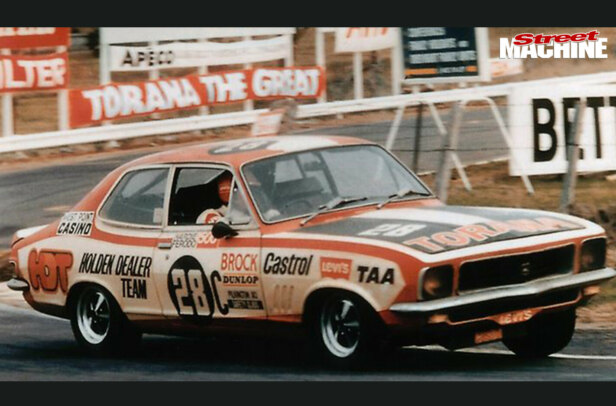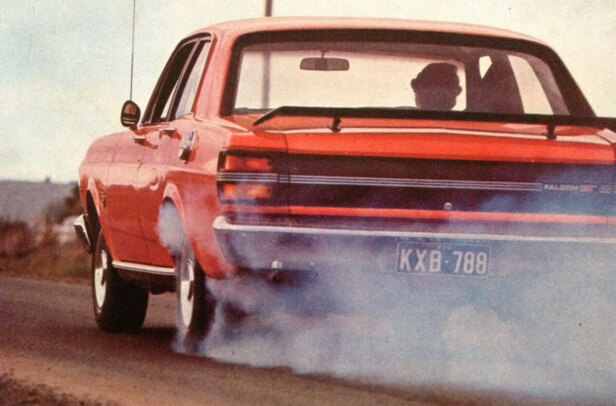PE 017 lives!
Larry Perkins’s ’93 Bathurst-winning VP Commodore has returned to the track after a seven-year restoration. The Perkins lads took delivery of the car February 2016, and have put in a massive effort to get the iconic Holden back to its original glory.
Larry himself jumped in the drivers seat to give the VP a shakedown run around Calder Park – the second ever track he raced at, way back in 1969. With everything so fresh he didn’t thrash the car hard, but safe to say it looks and sounds just as glorious as it did 30 years ago.
Check out the Perkins Engineering video to see Larry rowing through the gears and giving some (uncensored) feedback on the car’s dynamics. Of course, Jack Perkins couldn’t resist a try either!
Read on for the gory details on the legendary engine that gave the Holden V8 its final Bathurst victory in 1993.


LAST OF THE LIONS

The Holden and Ford rivalry at the Bathurst 1000 is as Aussie as koalas, servo pies and wanting anyone except the English to win at sport. Nearly 30 years ago, it was Holden’s turn to dominate, with Commodores grabbing the top five spots in the 1993 running of the Great Race. But that event was significant for another reason: Larry Perkins’s winning VP was the last car to take out Bathurst with a Holden V8 for power.
First published in the August 2022 issue of Street Machine
Back in ’93, critics laughed at the Formula One veteran and noted engineer for using an Iron Lion in his VP. At the time, the new Chevy V8s were the hot gear, and everyone thought the Perkins Engineering team was bringing a knife to a gun fight. But Larry and the late, great Gregg Hansford flogged everyone at Mount Panorama that year, setting the fastest time in practice, nabbing pole, and taking out the W come Sunday afternoon.
“They built two brand-new race engines for Bathurst 1993: #131 and #132,” explains Jack Perkins, Larry’s son. “Engine #131 was designated to be the race engine, and Dad can be a little impatient, so he dynoed it and said ‘let’s load it up’ to race team members Barry Abbettmeyer and Shaun Hockey. But Barry and Shaun took #132 and got the tune really spot-on, so they had to go to Bathurst and pull rank on the team owner to swap #132 into the car in place of #131, as they knew it was a better engine. And it was #132 that won the race.”
Immediately after the race, the other teams got together to protest the Holden V8’s “unfair advantage”, noting Larry’s F1-inspired slide-throttle intake. Not bad for an engine that was supposedly nowhere near as good just weeks before! The end result was a vote to ban the Holden V8 and slide-throttles from Level 1 cars for subsequent Bathursts.
“When they outlawed the Holden engine, the privateer teams (not outright Level 1 contenders) were still allowed to use them, and one of the core parts of the Perkins business was leasing and building race engines for customers,” Jack says. “So the Bathurst-winning engine was then used by Trimbole, McLeod, Mark Poole, David ‘Truckie’ Parsons, the Castrol Cougars used it at Bathurst in ’97, and then it went back to Parsons. Our records ran out in the back end of ’99 for the engine.
The Bathurst-winning VP Commodore was sold off at the end of the ’93 championship, and then passed through many hands and updates until it was bought back by the Perkinses nearly 10 years ago. “Around 2013, our friend David Gardner bought the Pro-Duct VP Commodore, and it came with two engines,” Jack explains. “He reached out to check the history of these two engines, one of which was engine #132.
A few weeks later, he turned up with a box trailer and this engine was in it; he donated the actual Bathurst engine back to us, as he felt it was important for our family to have it. At that stage we hadn’t sourced the car. It was unbelievably generous of David.”
Since then, Jack, a noted Supercars racer himself, has set about meticulously restoring chassis PE017 to as close as possible to how it started the 1000km classic that day nearly three decades ago.
The heart of this build is that 304ci EFI V8, but this isn’t a hotted-up 165kW unit found in VP Commodores, or even one of the spicy 215kW HSV Group A units. Larry had some tricks up his sleeve.
Coming into 1993, Larry had assistance from the head of the Holden engine plant, William Hamel. Larry and his team went down to the foundry to improve block and head castings, which strengthened the bottom end and saw inlet ports being raised 30mm. A week was spent building the blocks and heads, but this still only netted 50 of the former and 100 of the latter. Larry estimated they wound up with 20 engines and a bunch of spares, so these ‘Larry engines’ are real unicorns 30 years later.
For Bathurst ’93, Perkins Engineering had the specially-cast blocks machined and fitted with a Holden steel crank (PE09-93-015) from Crankshaft Rebuilders, and that unit remains in the engine to this very day. “It isn’t an exotic aftermarket crank,” laughs Jack. “Dad said there was nothing trick there with it; it was just balanced as an assembly.”
Engine #132 was built using all brand-new hardware, but it wasn’t an exotic piece of unobtanium. Holden VL conrods – not even Group A-spec items – were used due to their lighter weight, and, despite shot-peening and upgraded fasteners, this did cause some clenching of the slacks in the pits over the 1000km race distance.
“For Bathurst we used a standard Holden VL rod, but with upgraded bolts and balanced [to 612g each],” Jack explains. “They were a delicate part of the engine, and probably the most nervous part for us during the Bathurst race was just wondering if they’d last. For 1994 they were converted to Carrillo rods, which were slightly longer. Carrillos are still in it today, as we’d be just as nervous going back to Holden rods as we were in ’93.”
Above the rods, 9.4cc forged JE flat-top pistons weigh 510 grams each, giving 9.94:1 compression, and were made to Perkins Engineering specs from PE drawings. In 1993, the cam was a Crane IR 272-4168-4 hydraulic-roller, while the tie-bar roller lifters and roller rockers (1.65 ratio) were also from Crane.
A brand-new PE dry sump pan and Barnes four-stage pump were fitted to the five-litre fire-breather, while a Peter Jackson gear drive, Romac steel harmonic balancer and Harrop Engineering water pump pulley got the nod on the front of the engine. The water pump is a Holden item with a Perkins Engineering impeller to improve flow properties. Oil lines have been tapped directly into the galleries in the cylinder heads, and into the back of the block.
The specially cast heads were fitted with titanium Del West 2.02-inch inlet and 1.615-inch exhaust valves, plus GM pushrods and valve springs. “The valve springs were a nervous thing back in the day, too,” Jack says. “But if you don’t over-rev it and the drivers manage the rpm, it is all fine, as it was on the day.”
Amazingly, the first rebuild the Iron Lion copped was in March 1994, where it was fitted with the 6.250-inch Carrillo rods, along with new bearings, new valves and coated valve springs. The wear was so good that, even after 1900km, Perkins Engineering didn’t need to hone the block, and they retained the same crank, lifters, cam, balancer and gear drive!
The 2020 rebuild saw legendary touring car engine builder Neill Burns reuse the JE pistons but pair them with six-inch Carrillo rods and a Crane hydraulic-roller cam. The block runs an average bore size of 4.0020 inches, with 0.020-inch ACL bearings and a slight drop in comp down to 9.90:1.
Run on the Walkinshaw Racing engine dyno, this rebuilt legend made 542hp at 7500rpm, with 486.3lb-ft at 6000rpm. Larry estimated the Holden made 590hp in ’93.
We hope to see it roaring back to life under the VP’s bonnet soon!
Jack of all trades
Restoring a piece of history to a specific moment in time is a huge and painstaking undertaking. Thankfully, Jack Perkins grew up around these cars and has been able to work with many former employees, team members and devoted fans to fill in any gaps he found.
“When you restore these cars, you pick an event and stick to it,” says Jack. “Even the decals can change between events, so understanding the specifications of the car on race day comes through a series of documentation. We relied on a lot of our parts drawings for hardware, as they were dated. A lot of hardware, like engines, brakes, diffs, suspension uprights and the like, all got Perkins Engineering numbers.”
For the VP’s restoration, 1993 was the first year for the CAMS 3A 5.0L touring car rules, which also made it the first time cars ran without wet sumps and had the large front spoilers and rear wings.
Yet some parts slipped past the history books. “Two weeks before Bathurst ’93 a datalogger turned up, but we had to rely on photos to realise the car ran both the datalogger as well as an analogue tacho,” Jack explains. “The same for the gearbox cooler. What we couldn’t specify from our documentation we relied on fan photographs or from talking to people who were there.”
Another huge issue with old race cars is that they often keep racing after scoring their big win. “PE017 had raced on for 20 years, including as a Sports Sedan, so we had to repair a lot of old crash damage,” Jack explains. “It had 30kg of additional rollcage material welded in to improve torsional rigidity, and restoring the original ’cage was a massive undertaking. It also needed a new parcel shelf, rear guards and more.”
While the bodywork and rollcage had been updated and required a huge amount of surgical fab work to put back to VP specs, Jack did get some big wins elsewhere. “The car was actually quite a bit of a survivor; the front struts and rear hubs were from March ’93,” he says. “The fuel cell box was too heavily damaged to reuse, but we were able to exactly copy it. The original diff housing came with the car as a spare, so we were very lucky that so many parts were from 1993.”
Holden/Perkins Engineering cast block
| Capacity: | 304ci |
|---|---|
| Induction: | Perkins slide-throttles, custom trumpets |
| ECU: | Autronic SM4 |
| Heads: | Holden L castings, custom titanium Del West valves (2.02in inlet, 1.615in exhaust) |
| Camshaft: | Crane hydraulic-roller |
| Conrods: | Carrillo 6.250in |
| Pistons: | Custom JE forged |
| Crank: | Holden forged steel |
| Lifters: | Crane tie-bar roller lifters |
| Rockers: | Crane 1.65 & 1.50 aluminium |
| Pushrods: | Standard |
| Oil system: | Perkins Engineering pan, four-stage Barnes dry sump, Earl’s fittings |
| Fuel system: | Bosch #803 injectors, Earl’s fittings |
| Exhaust: | Custom Perkins Engineering headers |
| Ignition: | EFI distributor, Bosch Ford Fairlane coil, Bosch Holden Camira ignition module, CAMS 7500rpm rev-limiter |




Comments